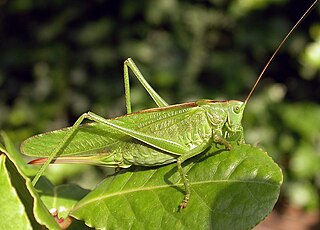
Ectobiidae is a family of the order Blattodea (cockroaches). This family contains many of the smaller common household pest cockroaches, among others. They are sometimes called wood cockroaches. A few notable species include:

Periplaneta is a genus of cockroaches containing some of the well-known pest species with cosmopolitan distributions, such as:

The Tettigoniinae are a subfamily of bush crickets or katydids, which contains hundreds of species in about twelve tribes.

Chthoniidae is a family of pseudoscorpions within the superfamily Chthonioidea. The family contains more than 600 species in about 30 genera. Fossil species are known from Baltic, Dominican, and Burmese amber. Chthoniidae now includes the former families Tridenchthoniidae, and Lechytiidae which has been demoted to subfamilies.
Tyrannochthonius rex is a species of pseudoscorpion in the family Chthoniidae. It is endemic to Australia.
Austrochernes is a genus of pseudoscorpions in the subfamily Chernetinae, first described by Max Beier in 1932. Species of this genus are found in mainland Australia and New Guinea. The Australian Faunal Directory decisions for synonymy are based on a 2018 paper by Mark Harvey.
Tyrannochthonius aridus is a species of pseudoscorpion in the Chthoniidae family. It is endemic to Australia. It was described in 2008 by Australian arachnologists Karen Edward and Mark Harvey.
Tyrannochthonius billhumphreysi is a species of pseudoscorpion in the Chthoniidae family. It is endemic to Australia. It was described in 2008 by Australian arachnologists Karen Edward and Mark Harvey.
Tyrannochthonius garthhumphreysi is a species of pseudoscorpion in the Chthoniidae family. It is endemic to Australia. It was described in 2008 by Australian arachnologists Karen Edward and Mark Harvey.
Tyrannochthonius souchomalus is a species of pseudoscorpion in the Chthoniidae family. It is endemic to Australia. It was described in 2008 by Australian arachnologists Karen Edward and Mark Harvey.
Tyrannochthonius brooksi is a species of pseudoscorpion in the Chthoniidae family. It is endemic to Australia. It was described in 1991 by Australian arachnologist Mark Harvey. The specific epithet brooksi honours Darren Brooks, who collected some of the type specimens.
Tyrannochthonius butleri is a species of pseudoscorpion in the Chthoniidae family. It is endemic to Australia. It was described in 1991 by Australian arachnologist Mark Harvey. The specific epithet butleri honours naturalist Harry Butler (1930–2015), who provided funding for fieldwork in the Cape Range.
Tyrannochthonius laevis is a species of pseudoscorpion in the Chthoniidae family. It is endemic to Australia. It was described in 1966 by Austrian arachnologist Max Beier.
Tyrannochthonius cavicola is a species of pseudoscorpion in the Chthoniidae family. It is endemic to Australia. It was described in 1967 by Austrian arachnologist Max Beier.
Tyrannochthonius queenslandicus is a species of pseudoscorpion in the Chthoniidae family. It is endemic to Australia. It was described in 1969 by Austrian arachnologist Max Beier.
Tyrannochthonius cavernicola is a species of pseudoscorpion in the Chthoniidae family. It is endemic to Australia. It was described in 1976 by Austrian arachnologist Max Beier.
Tyrannochthonius norfolkensis is a species of pseudoscorpion in the Chthoniidae family. It was described in 1976 by Austrian arachnologist Max Beier.
Tyrannochthonius kermadecensis is a species of pseudoscorpion in the Chthoniidae family. It was described in 1976 by Austrian arachnologist Max Beier.



